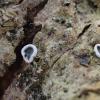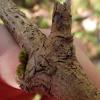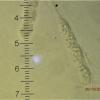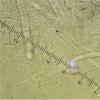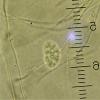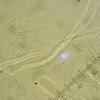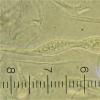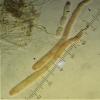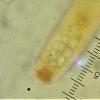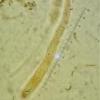
25-08-2025 17:37
 François Freléchoux
François Freléchoux
Bonjour,Nous avons trouvé samedi dernier à l'ét

20-08-2025 19:04
Ethan CrensonHello, This asco was found on the same wood as my

22-08-2025 08:41
Masanori KutsunaHello.Can anyone help me to get this article?Liu H

21-08-2025 02:18
Stefan JakobssonOn a necrotic section of a living Tilia cordata I
Discomycete with muriform(?) spores on Sambucus racemosa
Edvin Johannesen,
06-10-2020 14:04

Hi!
I am struggling with this tiny disco with a grey hymenium and a white, downy rim. I have only two apothecia, so not much to play with. Asci measure approx. 200 x 10 microns (in water) - shorter (ca. 150) in Lugol. Spores ca. 17 x 9-10 microns. They are either muriform or multiguttulate - it's hard to tell - and hyaline. The entire ascus "cap"is reddish-brown in Lugol (no pre-treatment with KOH). Paraphyses filiform, ca. 1 micron thick. Asci appear to be 4-spored or else 4 spores are consistently aborted.
Suggestions appreciated. Thanks.
Edvin Johannesen,
06-10-2020 14:05
Edvin Johannesen,
06-10-2020 14:06
Martin Bemmann,
06-10-2020 15:44

Re : Discomycete with muriform(?) spores on Sambucus racemosa
Hi Edvin,
perhaps a lichen. There seem to be enough algae visible on the macrophoto.
regards
Martin
Hans-Otto Baral,
06-10-2020 17:06

Re : Discomycete with muriform(?) spores on Sambucus racemosa
I cannot see pic 3 and on the other I do not see algae. The red IKI reaction of the apical ring is interesting. I suggest to test also IKI after KOH, whether the ascus wall also reacts.
The thin paraphyses seem strongly branched.
Cryptodiscus muriformis resembles somewhat your specimen, including the 4-spored asci, but the spores are much larger and the apos orange. Here the entire ascus wall reacts, but also a distinct apical ring.
Important would be a section to study the margin, and perhaps also the presence of algae.
The large oil drops mask the cell walls. If you mount in MLZ or CB, or CR, you will better see the walls.
Edvin Johannesen,
06-10-2020 17:38

Re : Discomycete with muriform(?) spores on Sambucus racemosa
Thanks to both for your comments. It turns out that this one has been collected several times along the coast of Norway. A paper is in progress. I think one of the author will comment here. Sambucus is a new host/substrate.



